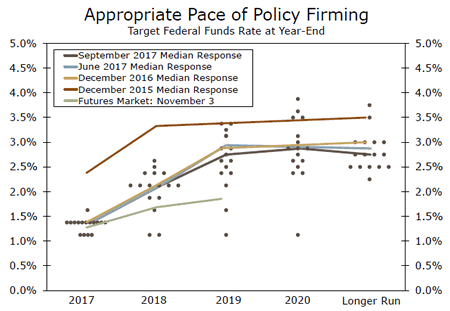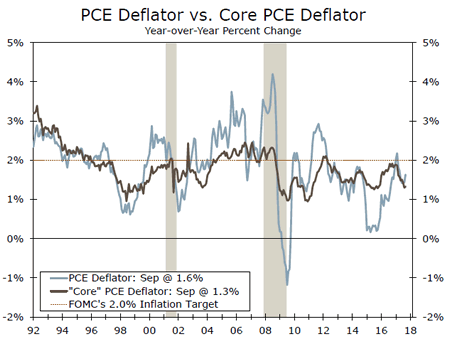U.S. Review
Everything is Awesome
- The data calendar this week was packed with major economic indicators that came in largely positive. This morning’s jobs report came in slightly lower than expected, but it was still solid, and the decline in September payrolls was revised away. The further drop in the unemployment rate to 4.1 percent underscored the labor market’s underlying strength.
- Cycle-high consumer confidence and expectation-beating personal consumption figures, combined with still-elevated readings from the ISM surveys, underscored the broad-based U.S. economic expansion.
Economic News Broadly Positive
The FOMC still appears ready to raise rates in December despite recent inflation misses. The Committee met this week but kept policy unchanged as expected. The statement released Wednesday was notably upbeat about the economy, as the FOMC upgraded the assessment of a "moderate" pace of expansion to "solid"—quite a strong word for this committee, which signals their confidence the planned December rate hike is on course.
Consumer spending accelerated at the end of Q3, with nominal consumption rising 1.0 percent in September. Inflation trimmed off 0.4 percent, leaving real consumer spending up 0.6 percent on the month. Spending was higher for both services and goods, with durable goods posting an especially strong increase. Hurricane related purchases were likely at work in September’s gain, and the absence of equally significant income growth on the month meant Americans dipped into savings to fund spending, which we delve into in the Credit Market Insight section of this report. The Fed’s preferred gauge of inflation, the PCE deflator, rose 0.4 percent on temporarily high gas prices caused by Harvey, but core inflation rose only 0.1 percent. Core inflation is up 1.3 percent over the year, stubbornly lower than the Fed’s target.
The employment cost index gained 0.7 percent in Q3, pushing the year-to-year growth up to 2.5 percent, which is close to the cycle high hit in 2015. The current upward trend should be more durable now that unemployment has fallen so low. Sustained strength in ECI growth would signal the Phillips curve still exists if slightly flatter, which should help inflation in the medium term.
Consumers are also remarkably confident about the economy. The Conference Board’s index of consumer confidence surged in October to 125.9—the highest level since 2000. While consumer confidence is now at its highest level since December 2000, the run-up in consumer confidence looks more reminiscent of the 1997 period, when consumer confidence surged out ahead of what had been an unusually slow economic recovery and eventually became the longest and one of the strongest expansions on record. Consumers’ broadly positive view on the present situation has been bolstered by continued strength in the job market and likely the upswing in the stock market. Expectations are back on the rise after losing some election-driven steam during summer months—an encouraging turnaround that we will watch closely.
The ISM manufacturing survey for October reiterated that the recovery in the factory sector is in full swing. October’s gauge fell only slightly from its cycle high point in September, underscoring the sector’s resilience from the recent hurricanes. New orders and employment held up well, though supplier deliveries were influenced by weather disruptions.
This morning’s jobs report was an apt bookend to the week of solid economic news. The U.S. added 261,000 jobs in October and the September drop was revised away. The jobless rate fell again, now at 4.1 percent—though there was also a big drop in the labor force that was more likely reflective of seasonal adjustment quirks than large scale workforce disengagement.
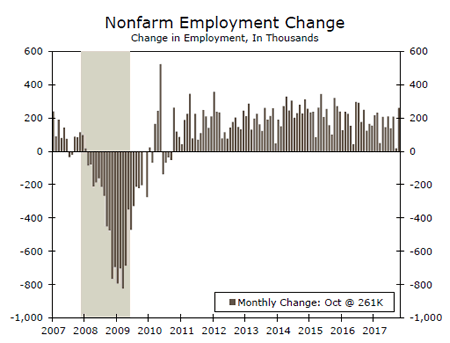
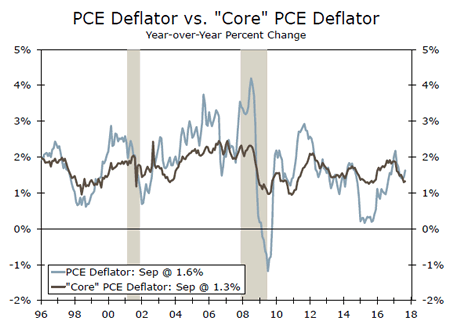
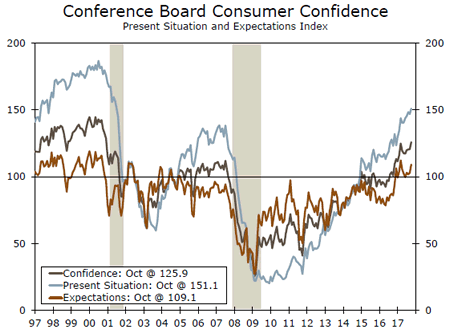
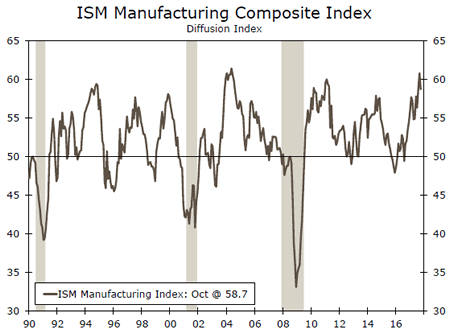
U.S. Outlook
JOLTS • Tuesday
The JOLTS report for September is due to be released next Tuesday morning. The job openings rate remained at a record high 4.0 percent in August as the level of openings ticked down only slightly. Compared to a year ago, postings are up 10.8 percent. The elevated level of job openings at the end of last month underscores that the September drop in payrolls was the result of the recent hurricanes and that demand for labor is holding up.
Turnover was lower in August, with both gross hires and separations falling over the month. Separations were dragged down by fewer layoffs, but also fewer workers quitting their job. The quit rate has stayed within the band of 2.1-2.2 percent this year, on par with the highs of the previous cycle. The higher rate of workers quitting should put some modest upward pressure on wages as jobs switchers tend to see stronger earnings growth.
Previous: 6,082K
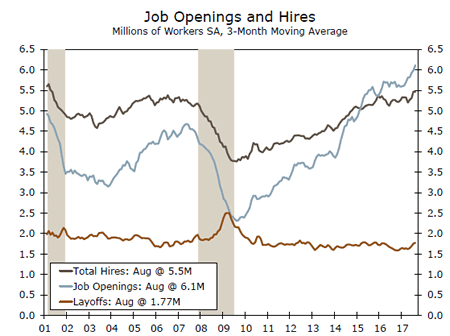
Consumer Credit • Tuesday
Next Tuesday will also see the release of the Federal Reserve’s consumer credit report for September. More recently, this indicator has garnered attention as the business cycle continues to lengthen. Potential softness in consumer purchases on credit in a rising rates environment may signal a greater economic slowdown around the corner. In August, consumer credit growth undershot expectations, with notable softness in nonrevolving credit. Nonrevolving credit is up just 3.2 percent year over year, compared to revolving credit which is up 7.0 percent on a year-ago basis.
Revolving credit remains a shade below its pre-recession peak while nonrevolving credit continues to set a new record each month. We expect both series to gradually climb from here. If the Fed continues to raise rates in the ‘slow and steady’ manner in which they have over the past year, then a sharp uptick in consumer debt delinquencies will likely not occur, all else equal.
Previous: $13.1 billion Consensus: $18.2 billion
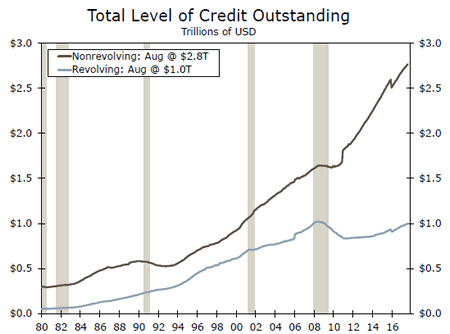
U. Michigan Consumer Sentiment • Friday
While the hard data are slowly catching up to the softer sentiment data, the gap still exists. This speaks more to the elevated levels of confidence data than any notable weakness in the hard data. The University of Michigan’s consumer sentiment index jumped 5.6 points in October to a new cycle high of 100.7. The proportion of consumers stating the country will have continuous "good times" rose by 8 percentage points, while the proportion that expects "bad" times fell 6 points. This survey tends to focus more on financial questions and is likely being pulled higher by the roaring stock market.
Inflation expectations for the next 12 months plunged to just 2.4 percent, which may raise a red flag at the Fed. The drop likely reflects lower gasoline prices following the earlier hurricane driven spike.
Previous: 100.7 Consensus: 101.0
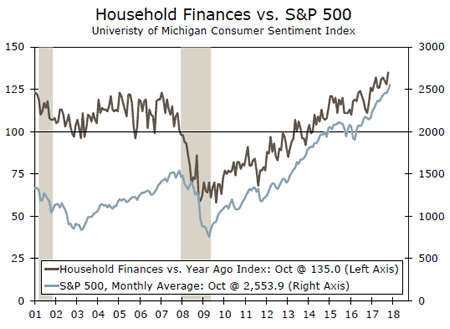
Global Review
Growth Strengthens in Europe, Weakens in Mexico.
- As we continue to see higher economic growth across the global economy, market expectations have shifted and are starting to believe that higher interest rates are actually possible, something that until a few years ago was almost unthinkable.
- The Bank of England increased interest rates for the first time in 10 years while the Eurozone economy grew at the fastest pace since Q1 2011, up 2.5 percent on a year-earlier basis. The Mexican economy slowed down further in Q3, up 1.6 percent on a year-earlier basis while declining 0.2 percent sequentially and not annualized.
Growth Strengthens in Europe, Weakens in Mexico.
As we continue to see higher economic growth across the global economy, market expectations have shifted and are starting to believe that higher interest rates are actually possible, something that until a few years ago was almost unthinkable.
To make the case even more interesting, on Thursday the Bank of England, which had not increased interest rates in more than ten years—it increased the rate the last time, from 5.50 percent to 5.75 percent, in July of 2007—joined the global bandwagon, increasing its target rate by 25 basis points, from 0.25 percent to 0.50 percent. Recall the Bank of England had lowered the rate from 0.50 percent to 0.25 percent in August of last year just after the Brexit referendum.
Meanwhile, earlier in the week and across the English channel, the Eurozone economy reported a better than expected advanced Q3 GDP result, up 0.6 percent, sequentially and not annualized, and 2.5 percent compared to the same quarter a year earlier. Furthermore, second quarter growth was revised up from 0.6 percent to 0.7 percent. The year-over-year growth rate was the strongest performance by the Eurozone economy since the first quarter of 2011 as the Eurozone continues to recover from the effects of the global financial crisis.
In the Americas, other than the better than expected increase in U.S. GDP in Q3, the news this week was not as positive, with Mexico reporting a decline of 0.2 percent in economic activity during the third quarter of the year, not annualized, and a growth rate of only 1.6 percent on a year-earlier basis. Although some analysts partially blamed the Mexico City earthquake for the weakness, we did not see much overall economic disruption in the aftermath of the earthquake in September. In fact, the performance of the supply sectors does not seem to have been disrupted by the natural event but by an overall weakening trend we have already written about in the past several quarters.
Furthermore, the Mexican central bank has been raising interest rates since December 2015, taking the benchmark interest rate to 7.0 percent from 3.0 percent in November 2015. Thus, there is some argument to be made that interest rates increases are also partially to blame for the weak performance of the Mexican economy. But perhaps the most important component of this weakness may have to do with uncertainty regarding the future of NAFTA and what this is doing to investment in the country, as measured by gross fixed investment, which tends to be the most volatile component of GDP year-in-year-out. Gross fixed investment declined 2.5 percent in July, year over year, and has been very weak during 2017, reflecting some of the uncertainty in the future of NAFTA and the Mexican economy. Having said this, the performance of the Mexican economy seems to be the exception that confirms the rule. And the rule lately is that global economic activity is not booming but has improved to a point that central banks across the world are taking back the massive monetary expansion of the last decade or so.
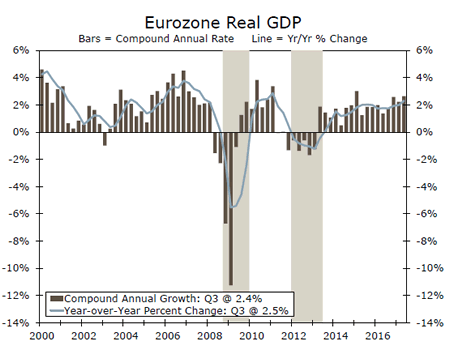
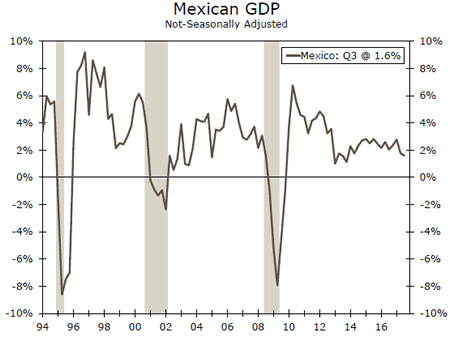
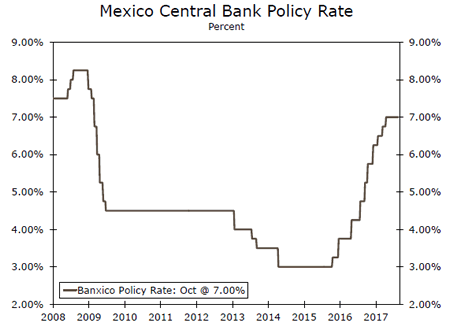
Global Outlook
Chinese International Trade • Tuesday
Growth in the value of Chinese exports and imports turned negative last year as the global economy decelerated and as commodity prices collapsed. However, Chinese international trade has perked up again this year as growth in global economic activity has firmed. Data that are slated to print next week will offer some insights into the state of Chinese trade at the beginning of Q4. The consensus forecast anticipates that the trade surplus rose significantly in October.
The slowdown that has occurred in the Chinese economy over the past few years has kept inflationary pressures in China at bay. CPI data for October will be released on Thursday, but we are not expecting a marked increase in inflation anytime soon. Money supply and credit data for October may be released at the end of next week. These data will offer some insights into the state of the monetary side of the Chinese economy at present.
Previous: $28.5 billion Consensus: $39.4 billion (trade balance)
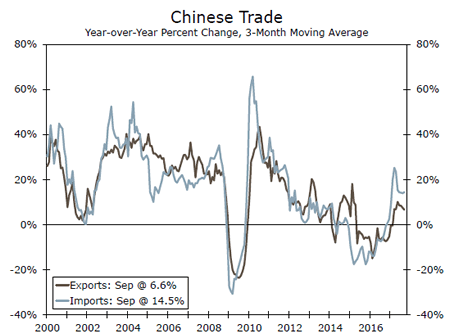
German Industrial Production • Tuesday
As noted above, growth in global economic activity has strengthened this year, and the German economy has participated in this development. Indeed, the year-over-year growth rate in German industrial production (IP) has risen markedly this year. Some payback in September following the surge in IP in August seems likely, but the factory sector in Germany probably remains resilient overall. Data on factory orders (Monday) and international trade (Thursday) will offer more soundings on the state of the German industrial sector at present. Analysts will use these data points to sharpen their estimates of German GDP growth in the third quarter, which will print on November 14.
Data on French and Italian IP for September, which are both on the docket on Friday, will offer a more comprehensive view of the Eurozone industrial sector at the end of Q3.
Previous: 2.6% Consensus: -0.8% (Month-Over-Month)
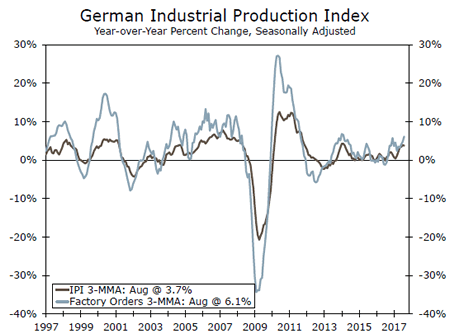
U.K. Industrial Production • Thursday
Growth in British IP has slowed this year along with the rest of the economy. Not only has uncertainty associated with Brexit restrained capital spending, but the rise in inflation has eroded growth in real income which has depressed growth in consumer spending. Both factors have contributed to the slowdown in British IP growth. The consensus forecast looks for IP to edge higher in September following its modest increase during the previous month.
Real GDP in the United Kingdom rose at an annualized rate of 1.6 percent in Q3-2017. The National Institute of Economic and Social Research, a well-respected think tank, will release its estimate of monthly GDP growth (for October) on Friday. We look for the British economy to continue to expand in coming quarters, but acknowledge that uncertainties associated with Brexit cloud the outlook.
Previous: 0.2% Consensus: 0.3% (Month-Over-Month)
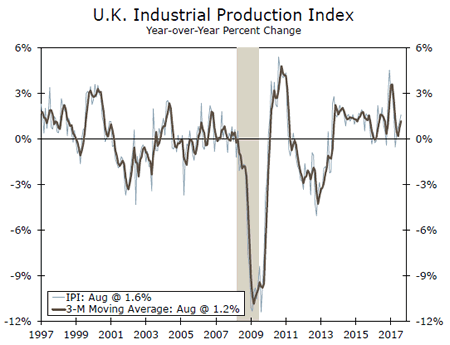
Point of View
Interest Rate Watch
Growth, Inflation and Rates
Fundamentals for growth and inflation continue to support a move by the FOMC to raise rates in December and again in the first half of 2018.
Growth Story: Solid
Signals from the ISM manufacturing, personal consumption and the capital goods orders reports support the case for growth in the current quarter and for the first half of 2018. The ISM index (top graph) showed continued strength in the manufacturing sector with solid above break-even indications in production, new orders and employment. Meanwhile, supplier delivery delays remained high indicating continued manufacturing production ahead.
Real personal consumption has risen at a 3.4 percent annual rate over the last three months. Both goods and services spending were strong. Finally, nominal nondefense capital goods orders are up 11.6 percent (annualized) over the last three months signaling stronger capex spending ahead.
Inflation: Upward Drift
As illustrated in the middle graph, the employment cost index (ECI) for both private industry and state & local government has risen steadily since mid- 2014. At 2.5 percent, the ECI is ahead of the 2.3 percent increase registered this time last year. The latest third increase was driven by a pickup in both wages & salaries and benefits.
For the private sector, the gains were widespread in professional & business services, manufacturing and transportation & warehousing. Interestingly, benefits expenses have slowed a touch as more health care benefit costs appear to be shifted onto the workers themselves.
The Result: FOMC to Raise Rates Ahead
Our outlook remains that the FOMC will raise the Fed funds rate at the December meeting and twice again next year. The bottom graph illustrates the implied path of the Fed funds rate along with the anticipated path for the PCE deflator.
What is intriguing here is that the path of the future Fed funds rate passes above the path of the PCE This creates a scenario with a positive real interest rate at the short end of the yield curve—a situation we have not seen for quite some time. This will alter the benefit/cost ratio for financing those credit-dependent sectors of the economy.
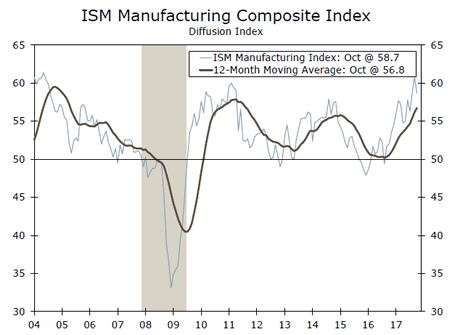
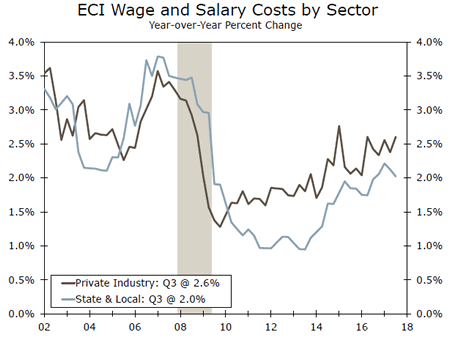
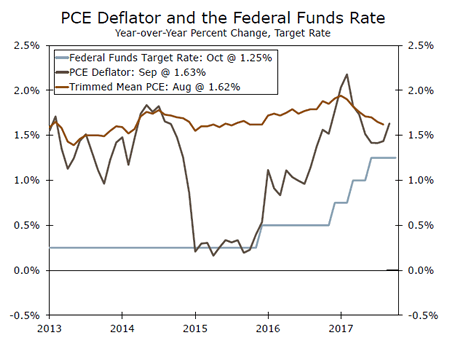
Credit Market Insights
Consumers Using Savings as ATMs
This week’s personal income and spending figures showed strong spending among consumers in September that was supported not by impressive income gains, but by consumers’ savings accounts. The savings rate is at a cycle low of just 3.1 percent now, down from 3.6 percent in the first two months of Q3. Driving this substantial drop in savings despite relatively weak income growth is sky high confidence.
Consumer confidence has not been as high as it is today since 2000. Confidence is abundant broadly over the overall economic situation, but with respect to personal spending and personal income’s divergence, perhaps the most telling results of October’s consumer confidence survey is the measure of income expectations. Survey respondents across all income distributions believe that they will be better off financially over the next five years. The optimism of personal income growth as well as rapidly accelerating home prices and record stock market highs is likely what led consumers to dipping into savings to fund spending increases in September.
While spending and consumer confidence measures may seem to point to prolonged periods of prosperity, this kind of consumer behavior is unsustainable other than on a short-term basis. The only way this level of spending can be maintained is if income growth picks up, or if consumer borrowing increases to support expenditures, as current spending levels cannot be supported by savings in the long run.
Topic of the Week
Powell Nominated to Lead Fed
Jerome Powell has been nominated to head the Federal Reserve Board as we explored in a special report, which is available upon request. The official changing of the guard will not occur until Chair Yellen’s term expires on February 3, 2018. Not surprisingly, financial markets have not reacted strongly one way or the other on the heels of this announcement, as Governor Powell is largely expected to pick up where Chair Yellen leaves off. Powell’s nomination does not change our outlook for monetary policy at this time. However, reviewing Powell’s previous public comments is an interesting exercise to discern how his views may differ slightly from the current Fed Chair. How might we view his comments on policy and financial markets? What would we ask at confirmation hearings?
Normalization of Policy
The Economic Club of New York, (June 1, 2017) "While monetary policy can contribute to growth…, it cannot reliably affect the long-run sustainable level of the economy’s growth." From an economist’s point of view, this is well-said. However, how will the Senators respond to the case for monetary neutrality? Question— what is your estimate of that long-run sustainable pace? "The normalization process is projected to have several years to run…the endpoint long-run neutral rate of interest." OK, but what is your estimate of that rate— especially given that the FOMC’s estimated rate has declined in recent years (Figure 1)?
"Once the process of balance sheet normalization has begun, it should continue as planned as long as there is no material deterioration in the economic outlook." Excellent, judgement matters but how will you recognize "material deterioration" given the difficulty of forecasting, especially recessions, and given the perception of lags in the impact of monetary policy?
Likely More of the Same
Against the backdrop of cycle-low unemployment and modest economic growth, the new Fed chairman should be able to continue to gradually raise interest rates from historic lows.
